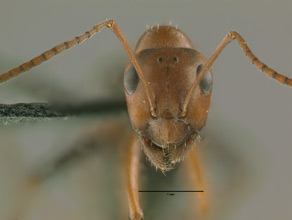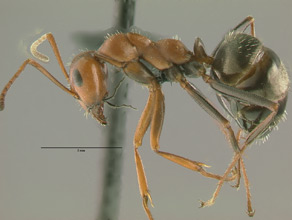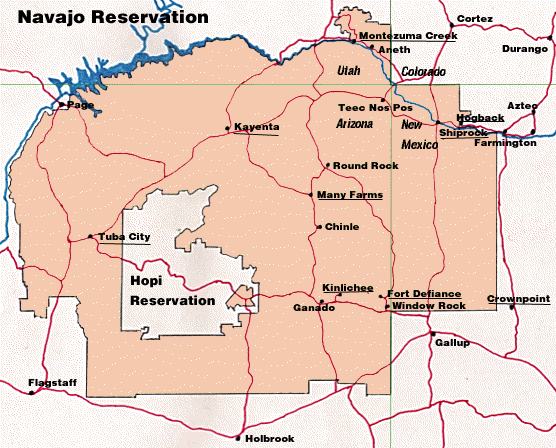- Identification
- Just approaching medium-sized, the bicolored (black, or darker brown to reddish brown, gaster with lighter colored, yellowish-red alitrunk and head) Formica obtusopilosa workers have a dense gastric pubescence. This species belongs to the sanguinea species group, which is behaviorally differentiated from other Formica species by their slavemaking habitats. They may be found in colonies that contain a mix of conspecific and heterspecific workers.
- Morphologically the combination of dense gastric pubescence and an indentation in the middle of the clypeus or, more technically, a median concave impression on the anterior border of the clypeus set sanguinea species apart from other North American Formica. Erect light colored hairs (whitish to whitish yellow) that are larger towards their truncate tips differentiate these ants from other Navajo Reservation sanguinea species.
- Biology
- Nests in the soil in open grassy areas. Chambers may be found under stones or there may be a small earthen mound surrounding exposed ground entrances. Colonies can contain up to a few hundred workers.
- additional biology notes...
- Distribution
- Range
- Canada and United States. Rocky mountain region from New Mexico to Alberta. Also occurs in the Black Hills of South Dakota.
- Navajo Reservation Records
- Collection records being processed.
- Additional Notes
- Formica obtusopilosa is a member of the North American sanguinea species group within the genus Formica. The sanguinea are ants that parasitize and enslave other Formica species but most are not obligately dependant on having enslaved ants in their nest. These raiding ants often restrict their attention to specific Formica subgroups (e.g. the fusca, neoformica or neogagates species groups). They do not appear to specialize on any single Formica species, at least for the wider ranging species. All the sanguinea species are dependent upon parasitizing a foreign host species for starting new nests; newly mated queens must enter the nest of another Formica species, kill the queen, and be adopted by the workers in order to succeed in founding a new nest.
- The ability, or lack thereof, of this species to enslave other ants had previously led to some confusion regarding classifying this ant as a sanguinea species. More recently Mackay and Mackay (2002) reported finding a nest that contained other Formica species.
- Slave raiding is a highly coordinated set of behaviors carried out in a stereotypical manner (as in this account of Formica gynocrates nest raids): a raiding party is initiated after a scout successfully locates and reports back to the colony that there is a raidable colony. Workers will swarm to and enter a targeted nest, with stolen larvae and pupae brought back to the raider's colony. Most of the larvae are used for food while some of the pupae are are allowed to eclose, in what is to them a foreign colony. Ants that eclose within a foreign nest subsequently behave as if the colony is their natal nest. The enslaved workers thus care for the brood, maintain the nest, forage and even participate in future raids.
- Etymology
- Morphological. obtusus = obtuse, blunt, dull + pilosus = hairy


- Literature
- Emery, C. 1893. Beiträge zur Kenntniss der nordamerikanischen Ameisenfauna. Zoologische Jahrbücher, Abteilung für Systematik, Geographie und Biologie der Tiere. 7:633-682.
- Mackay, W. P. and E. Mackay. 2002. The ants of New Mexico (Hymenoptera: Formicidae). Edwin Mellen Press, Lewiston, NY.
- Wheeler, W. M. 1913. A revision of the ants of the genus Formica (Linné) Mayr. Bulletin of the Museum of Comparative Zoology at Harvard University. 53:379-565.
- A note about these publications. The literature cited here is not meant to be an exhaustive list of papers published about this species.
Page authored by David Lubertazzi and Gary Alpert


